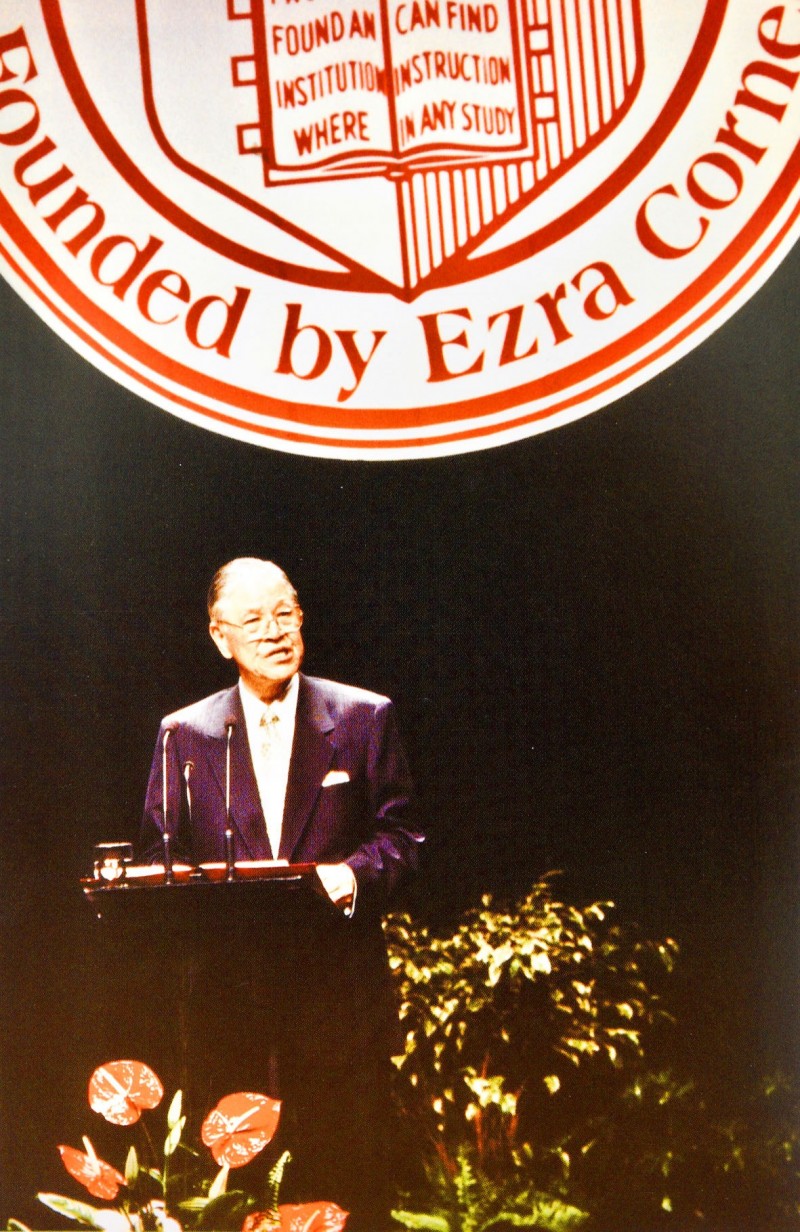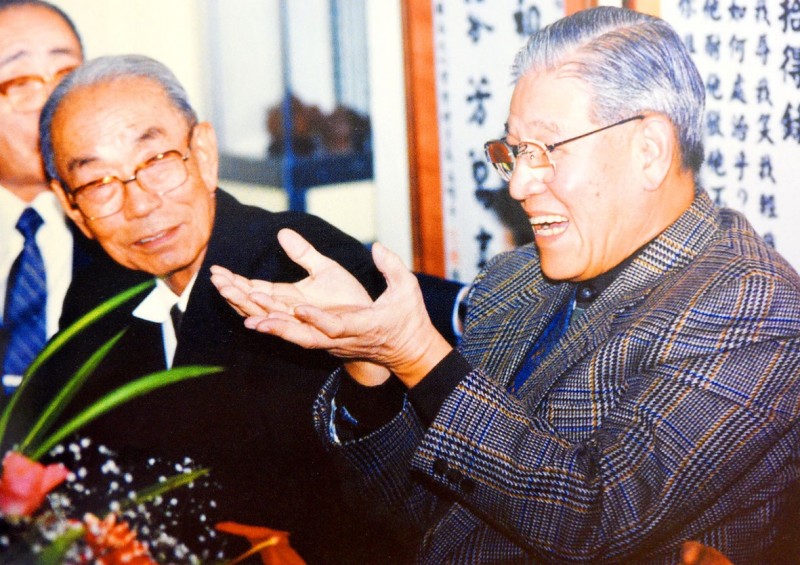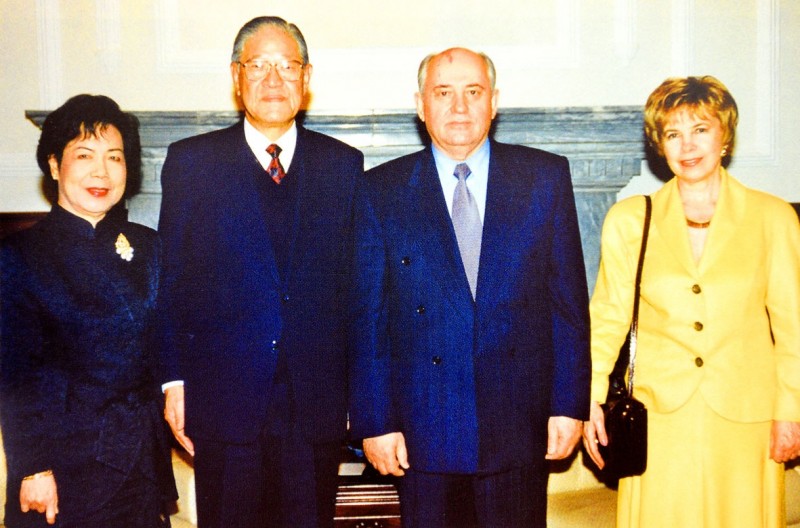《TAIPEI TIMES》 ‘Mr Democracy’ a man for his time

Then-president Lee Teng-hui gives his Always in My Heart Cornell commencement address at Cornell University in New York in 1995. Photo courtesy of Academia Historica
ROAD TO HISTORY: When Lee Teng-hui joined the KMT, the likelihood of a Taiwanese becoming ROC president, much less its first directly elected one, was hard to imagine
By Sean Lin and Sherry Hsiao / Staff reporters
Lee Teng-hui (李登輝), who was born on Jan. 15, 1923, in the farming community of Sanshi Village, Taihoku Prefecture — now New Taipei City’s Sanzhi District (三芝) — during the Japanese colonial era, and rose to become mayor of Taipei and not only the Republic of China’s (ROC) first Taiwan-born president, but its first directly elected one as well.
Educated in the Japanese educational system of the time, Lee, who spoke Japanese, Hoklo (also known as Taiwanese), Mandarin and English, won a scholarship to Kyoto Imperial University, but his studies were interrupted by World War II.
He earned a bachelor’s degree in agricultural science from National Taiwan University (NTU) in 1948, and appeared headed for an academic or civil service career, going on to earn a master’s degree from Iowa State University in 1953 and a doctorate from Cornell University in 1968.
He worked for the US-sponsored Joint Commission on Rural Reconstruction and also taught at NTU and National Chengchi University.
After joining the Chinese Nationalist Party (KMT) in 1971, the following year he gained his first government appointment, as a minister without portfolio with responsibility for agriculture.
He served in that position until June 1978, when he was appointed mayor of Taipei, a post he held until December 1981, when he became governor of the then-Taiwan Provincial Government, serving until 1984, when he became vice president of the ROC.
He succeeded president Chiang Ching-kuo (蔣經國), who died on Jan. 13, 1988, although the move was opposed by many Mainlanders within the KMT, including Chiang Kai-shek’s widow, Soong Mayling (宋美齡), who returned from the US to help other conservative Mainlanders to sideline Lee as president and block his accession to the KMT chairmanship.
However, Lee was deft enough to secure enough support to stay in office.
In 1991, he ended the Period of National Mobilization against Communist Rebellion and pushed for the re-election of the “1,000 year” National Assembly and the Legislative Yuan, whose members had served since 1948.
He also oversaw a major reshuffle of the Executive Yuan.
In 1995, he became the first ROC president to publicly apologize for the 228 Incident, and also made waves by returning to Cornell University to deliver a speech.
The following year he became the first directly elected president after the Third Addition to the Constitution established that the nation’s president and vice president should be directly elected.
His unparalleled contributions to democratizing the nation and his election that year earned him the nickname “Mr Democracy” from Newsweek magazine.
During his time as president and as KMT leader he favored highlighting Taiwan’s sovereignty and right to self-determination, and also pushed his special state-to-state model of cross-strait relations.
His relationship with the Democratic Progressive Party was highlighted by both rivalry and camaraderie, which is perhaps best exemplified by his collaboration with then-DPP chairman Hsu Hsin-liang (許信良) to freeze the Taiwan Provincial Government in 1997.
He was blamed by many hardliners in the KMT for the party’s loss of the presidency in 2000 to the DPP’s Chen Shui-bian (陳水扁), which eventually led to his being expelled from the party.
In August 2001, he formed the Taiwan Solidarity Union.
In 2004, Lee supported Chen’s re-election and in 2012 and 2016 stumped for Tsai Ing-wen (蔡英文) in her bids to become president.
Today, members of the DPP and pro-independence advocates see Lee as a visionary on the nation’s path to democracy and its efforts to achieve self-determination.
Democracy advocate Peng Ming-min (彭明敏), 96, said there were two contradictory identities in Lee — one was his status as a Taiwanese and the other was his position as KMT chairman.
The last time he saw Lee was at the founding of the Formosa Alliance in Kaohsiung, Peng said.
Lee made great contributions during Taiwan’s period of economic, political, cultural and social transformation, Peng said, adding that he believes Lee will always have an important position in Taiwan’s history.
Additional reporting by Lee Hsin-fang and Diane Baker
新聞來源:TAIPEI TIMES

Then-president Lee Teng-hui, right, gestures during a visit to Muzha in then-Taipei County on April 3, 1992, with former Japanese prime minister Takeo Fukuda, second right. Photo courtesy of Academia Historica

From left, Tseng Wen-hui and then-president Lee Teng-hui pose during a meeting with former Soviet Union president Mikhail Gorbachev and Raisa Gorbacheva in Taipei on March 23, 1994. Photo courtesy of Academia Historica

The Dalai Lama, left center, holds hands with then-president Lee Teng-hui during their meeting at the Taipei Guest House on March 27, 1997. Photo courtesy of Academia Historica

















